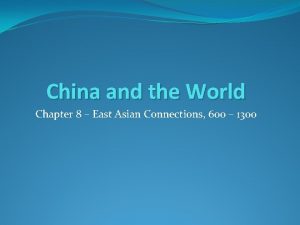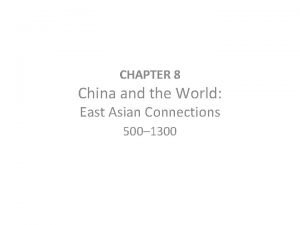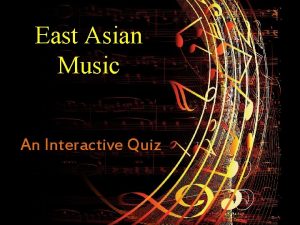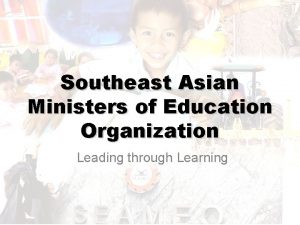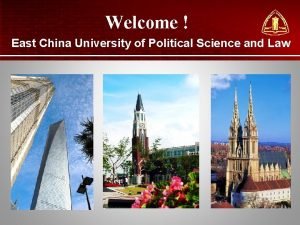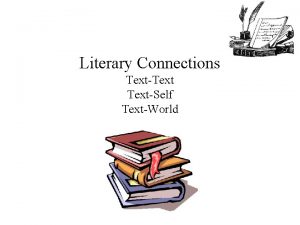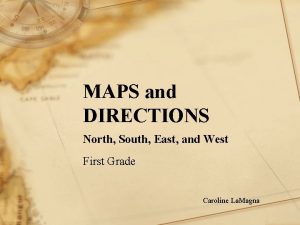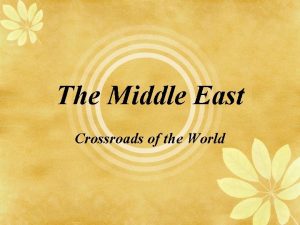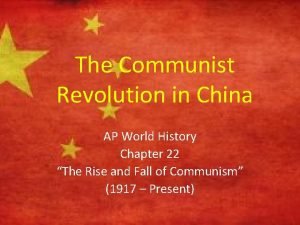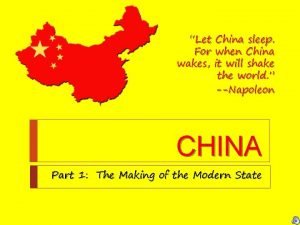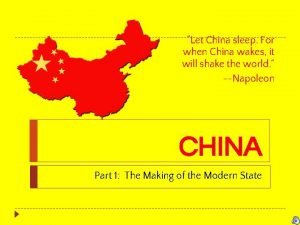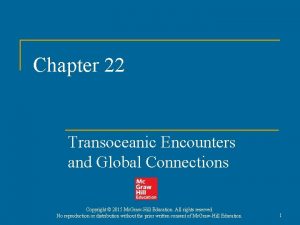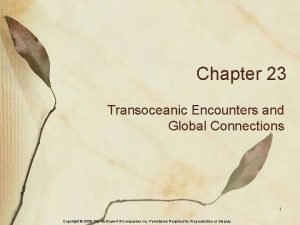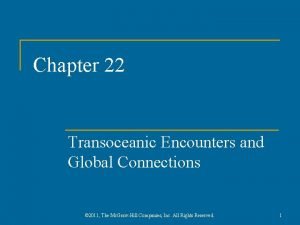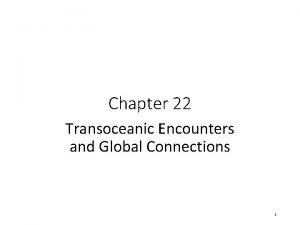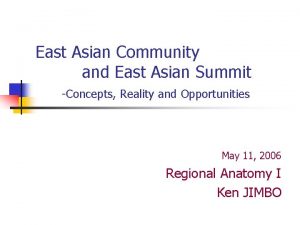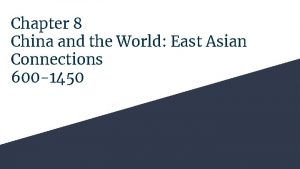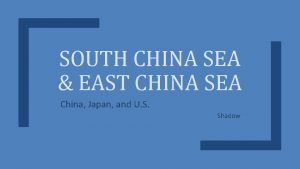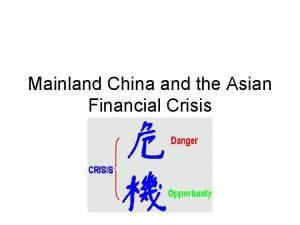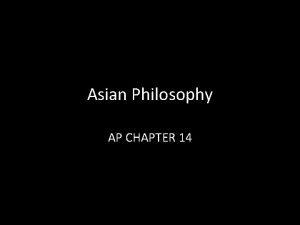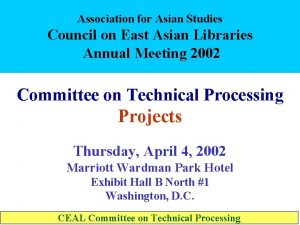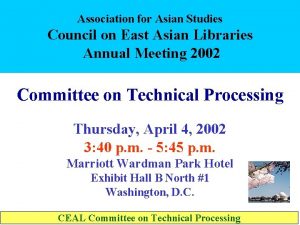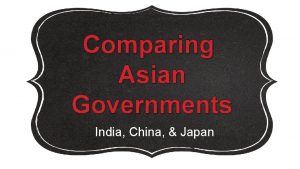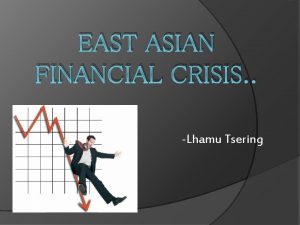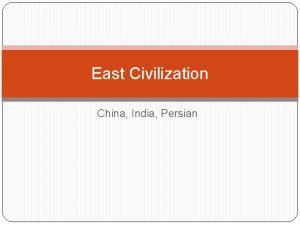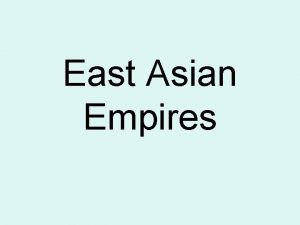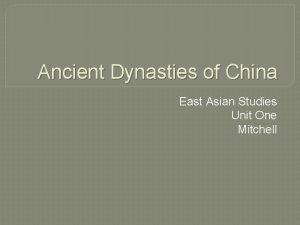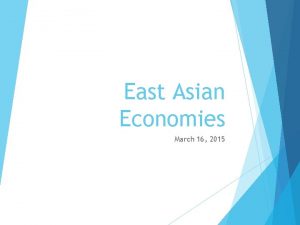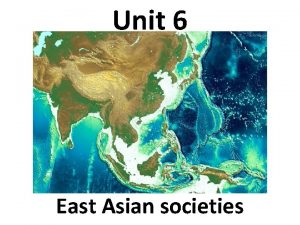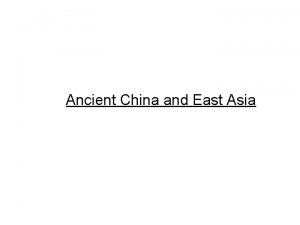China and the World East Asian connections Ch











































- Slides: 43

China and the World: East Asian connections Ch. 8 To explore the role of China as a third wave superpower. To examine China’s deep influence on East Asia To consider how interaction with other peoples had impact on China To encourage YOU to see China in light of its history and not just the last 70 year

China: Introduction to the Tang and Song Period • • China may be the next modern superpower China was a “superpower” in the third wave post classical period Chinese centered world order in most of East Asia Borders reached far into Central Asia Wealth and culture lured many visitors and admirers All of its neighbors were influenced in some degree by China Economy and technological innovation impacted throughout Eurasia China itself was affected by non-Chinese nomadic military threats throughout the period. International trade was also a means to change

TANG DYNASTY FLAG SONG DYNASTY FLAG

Reemergence of a Unified China • After the end of the Han Dynasty 300 years of political fragmentation • Nomads invaded from the north, Confucianism became discredited in many minds, and Han (Chinese) began migrating towards the southern Yangzi river valley. • An aggressive new Dyansty (Sui ruled 589 -618) reunified the state. Sui rulers extended the canal system and pursued warfare with neighbors. Failure to win and conquer nearby Korea exhausted the state’s resources and the dynasty lost the Mandate of Heaven. • However, unified China did not fall apart. A new Dynasty the Tang (618 -907) took control.

China under the Tang (618 -907) and Song (960 -1279) Dynasties • These two dynasties built on the foundations the Sui had created for a unified state. • Tang and Song established the patterns of Chinese life that lasted well into the 20 th century (and some might argue still exist) • The Tang Dynasty was the great Buddhist era in China • The Song Dynasty is considered a “golden age” of literature, arts, and culture • A closer examination of political life, economics, and social structure will follow.

Tang and Song Politics • Six major ministries were created to function with the Emperor to govern the state along with a Censorate to watch those who governed • The examination system was revived to staff the bureaucracy needed to govern • Many new schools and colleges were established for this purpose • Most officials were sons of elite landowners although some room for social status improvement was left • Large landowners continued to be powerful although both Tang and Song governments continually tried to restrict large estates and redistribute land to the peasants.

Tang and Song Economics • There was an economic revolution of sorts particularly after 960 • Great prosperity led to a growing population rising from 60 million in 900 to 120 million in 1200 which could well have been 1/3 of the earth’s human population • Agricultural production increased with the absorption of southern China- two or three rice crops per year, dryland rice farming, and use of new techniques for planting and plowing. • Led to the rise of large urban areas, China being the most urbanized state on earth by 1200. Several cities exceeded 1, 000 people.

Tang and Song Economics • Network of internal waterways for distribution and transportation was created using rivers, lakes, and canals • Industrial production improved especially in the production of iron • Chinese printers invented both woodblock and movable type printing to replace manuscripts as well as developing the first true paper • China had the world’s foremost shipbuilding technology and navigation technology as well. • Chinese alchemists also invented gunpowder utilizing it for fireworks as well as for weapons.

CHINESE JUNK and EUROPEAN VESSEL OF THE SAME PERIOD

MOVABLE TYPE CHINA C. 1000 CE

GUNPOWDER PRODUCTION

Tang and Song Economics • Production in many areas was for the market and not for local consumption. • Cheap transportation (remember those canals) allowed peasants to specialize in crop production and become members of the money economy • Growing use of paper money (Song) and banking • China was so rich that taxes had to be paid in cash not in kind and silver was the preferred coin

Society in Tang and Song: Women’s roles and lives in China 600 -1260 CE • Under Tang rule northern Chinese elite women played an important role in society (Empress Wu) possibly due to influence of nomadic peoples in area. This doesn’t mean women were considered equal. • Under the Song the position of women, especially elite women, deteriorated • The Song society tightened restrictions on women, imposing an ever more repressive patriarchy • Literature of the time (the Golden Age) when dealing with women, highlighted their subjugation to men

Women’s Roles in Tang and Song China • Foot Binding: one of the most well known of Song China’s impositions of servitude on women • Started in the 10 th or 11 th century: • A. associated with male notions of female beauty and eroticism • B. kept women restricted to the house • C. only practiced by(on? ) elite women. Peasant women had to work and had no social standing anyway.


Women in the Tang and Song • Women were displaced from traditional roles in textile making as the industry became larger. • Women had to find other jobs and roles to play • Major urban areas were more likely to provide jobs for these women as entertainers, courtesans, prostitutes, and concubines. Other jobs surely existed as well. • In some areas women’s positions improved: property rights expanded in some areas of the state, and elite women were better educated in order to raise their sons better in the Confucian traditions.

China and the Northern Nomads: A constant menace and source of change for 2000 years • For most of its history, China’s most frequent interaction with outsiders was in the north with the steppe peoples. Who these peoples were varied over time, but the interactions with the Chinese remained constant • Northern nomads lived in small kinship groups which occasionally developed into strong states or more likely confederations usually of short duration. • These pastoral societies needed grain and other farm products from China, and steppe leaders wanted Chinese luxury and manufactured goods.

STEPPE NOMADS

Interactions with Steppe Nomads • Pressure from these steppe peoples and invasion was a constant factor in Chinese history well into the modern era (c. 1640) • Nomads, however, often felt threatened by the Chinese Dynasties considering Chinese attacks on the steppes (to get horses usually) or the building of the Great Wall , built to deter steppe nomads from entering China for most purposes. • China needed the nomads as they provided horse (which the Chinese did not raise) as well as other goods such as leathers and furs. Nomads also controlled the Silk Roads for much of the period.

The Tribute System: Theory and Practice • The Chinese believed themselves to be the “Middle Kingdom” that is the center of the world and far superior to all other people • They established a tribute system to manage relations with non-Chinese peoples a system that apparently worked for centuries • A. Non-Chinese authorities (other governments must acknowledge Chinese superiority • B. Must present tribute to the emperor • C. Would receive trading priviledges and bestowals in return (often worth more than the tribute) • D. No exceptions were made to this rule as long as the Chinese could enforce it

The Tribute System: the Reality • The Tribute system didn’t always work as expected or serve the Chinese well. Some contradictions were inherent in the system • First, many nomadic empires could deal with China on fairly equal terms. Id est: Xiongnu confederacy, Turkic empires in Mongolia and Central Asia, and of course the Mongols • Second, although the tribute system was in place to keep nomads out, very few actually wanted to conquer and rule. They preferred to extort riches from China in return for peace. When China experienced internal disruption, steppe nomads might take over sections of the state especially in the north.

Culture: China and Nomads-who influenced who? • Nomads often adopted or adapted Chinese ways if they ruled parts of China for any length of time • But Chinese culture did not have a great impact on steppe nomads in general • Pastoral societies retained their own cultural norms; not being able to sustain agriculture precluded them from organizing their society on Chinese lines even if they wished to which they did not.

Cultural Interactions • Interactions took the form of trade, war, extortion, negotiations, and seepage of culture: essentially how interactions happen today • Steppe cultures did influence the parts of China which were often invaded and ruled by nomads: • Tang and Sui dynasties were “mixed” blood • Tang Dynasty: fad for anything connected with “western barbarians”(most likely steppe nomads) by northern Chinese elites. • Elites often have tastes for the exotic that are not affordable to the lower classes.

China and East Asia: Korea, Vietnam, Japan • All three of these emerging states had tributary relationships with China (see above for Tribute System) • They were agricultural, sedentary societies shaped by their proximity to China but not becoming Chinese • In a way this is similar to 20 th century African and Asian societies that accepted elements of Western culture while retaining political/cultural independence.

Korea and China • Interaction with China started during Han Dynasty with temporary Chinese occupation of northern Korea • Korean states emerged c 300 -699 CE: rival to each other, also resisted renewed attempts at Chinese political control • During Tang Dynasty in China Korean kingdom of Silla allied itself with Tang bringing some political stability to Korea up to 900 under Silla, to 1392 with Koryo, and to 1910 with the Yi dynasties.

Korea and China • Although politically independent and culturally different, Korean Dynasties look to China to provide legitimacy for their rule. • Made efforts to reproduce Chinese court life and administration • Modeled capital city of Kumsong on Chang’an Chinese capital • Chinese luxury goods became prized as did Chinese scholarship and religious influence • Confucianism imported with other Chinese cultural artifacts had a negative impact on Korean women after 1300

Korean maintains its culture • Despite the nearness of China and the influence of its culture, Korea remained itself. • Chinese influence was confined to the small upper classes and little effect on the large serf-peasant population or slave class. • Only Buddhism of all Chinese imports had a lasting cultural influence • The examination system imported from China never won over most elites and failed to become the determinant of success in government in Korea • In the 1400’s Korea adopted a phonetic alphabet (Hangul) replacing Chinese-like characters. This is more important than it seems.

Vietnam and China • Vietnam’s relationship with China was fairly similar to that of Korea • Vietnam’s cultural heart was part of the Chinese state from the 2 nd to 10 th centuries CE. • The Chinese made a great effort to sublimate Vietnam’s elites culturally a stance that also provoke rioting and rebellion • Vietnamese rulers adopted Chinese approach to government • Used examination system and the elite remained deeply committed to Chinese cultural values despite the movement of time

Vietnam and China • Yet much of distinctive Vietnamese culture remained in place. • Language remained distinct, entertainments were culturally different, women had greater roles in public life than in China • Nature goddesses were retained and when Buddhism was introduced, the Vietnamese had a female Buddha as well • Developed a version of Chinese writing called CHU NOM. • Vietnamese life did not revolve around urban areas but large villages knit together by ties of kinships and obligation perhaps insulating villagers (the majority of the population) from Chinese influences


Japan and China • Japan was never invaded or conquered by China so its borrowings from China were voluntary • Main period of cultural borrowing was from 600’s to the 800’s CE when first unified Japanese state appears • Creation of a Japanese state apparatus like that of China began under Emperor Shotoku Tasihi using the examination system etal • Large scale diplomatic and educational tours to China to learn from them • Creation of the 17 Article Constitution and two capital cities both modeled on Chang’an were built –Heian(Kyoto) and Nara.

Japan and China • Many elements of Chinese culture took deep root in Japan • Several schools of Chan Buddhism developed • Art, architecture, education, medicine, and some religious views were adopted • The Japanese also used the Chinese writing system • But they borrowed selectively and not wholesale • Japan never created an effective centralized state, political power became localized, and local powerful lords created their own effective territories and warriors (samurai)

Japan and China • While Buddhism did have followers and indeed became important in Japanese culture, Japanese Buddhists essentially married Buddhist philosophy to their indigenous belief systems. The kami (sacred spirits) later referred to as Shinto remained the main religious focus of most Japanese • Distinctive Japanese literary and artistic culture developed • Unique writing system mixed Chinese and phonetic characters. Developed Tanka (highly stylized poetry) • Heian Court highly aesthetic. Elite women in Japanese society escaped the extreme oppression of their sisters in China

China and the Eurasian Economy • Spillover impacts of China on the rests of Eurasia • Spillover is an economic term which can be good or bad. In this case it is good. Spillover in this sense is a positive benefit that comes to someone without them having to do anything to get it. This is what the influence of China on other’s economies is. • Many of China’s technological innovations spread beyond its frontiers • Examples: salt production through solar evaporation; papermaking; printing; gunpowder (with differing uses in different places); textile, metallurgic, and naval technologies inspired imitation such as the magnetic compass) Economic life all over Eurasia increased as a result of China’s

China as the receiver of Economic Benefits • So how did China make out from trade and interaction with others economically? • China learned how to process cotton and sugar from India • New strains of rice from Vietnam transformed Chinese agriculture around 1000 CE • China increased its participation in the Indian Ocean trade. Foreign merchant settlements in southern Chinese ports by 700 CE. Some violence accompanied this as in all trade entrepots. Southern China became an export driven market rather than one for subsistence.

CHINA AND THE BUDDHA BUDDHISM CAME TO CHINA FROM INDIA, BY FAR THE MOST IMPORTANT AND PRECIOUS ITEM EVER PASSING OVER THE SILK ROAD.


Buddhism and China • China’s only widescale borrowing from abroad until the advent of Marxism in the 20 th century • China was the base for the spread of Buddhism to Korea and Japan • Buddhism entered China in the 1 st and 2 nd centuries CE along the Silk Road • Because Indian culture was so different from Chinese Buddhism had little appeal or impact at first.

Rooting Buddhism in China • The fall of the Han Dynasty and the disorders entailed over the next 300 years discredited Confucianism • The nomadic rulers in the north of China prior to the Tang favored Buddhism • Monasteries provided social services the state could no longer do • Buddhism was comforting for the masses • Buddhism appeared to give access to magical powers • Mahayana Buddhism made a serious effort to appeal to the Chinese and succeeded. Buddhism became very popular

Buddhism in China • Before long Buddhism received state sponsorship from the Sui and Tang Dynasties • Emperors of both dynasties dedicated land for monasteries include 5 from Sui Wendi • Monasteries became very wealthy but also a servant of the state. • But all was not golden: Confucian traditions remained very strong especially in elite circles. The rapid penetration and growth of Buddhism provoked reactions against it.

Buddhism in China • There was criticism of the huge wealth of the monasteries, of the monks themselves who were celibate and this was offensive to the Confucian based patriarchal system as withdrawal from the world. Daoism could be tolerated because it was Chinese; Buddhism was foreign and feelings were different. • An Lushan Rebellion in 755 -763 probably a xenophobic reaction against Buddhism. However, Buddhism retained state support for a while longer.

Buddhism in China • In the 840’s, the Chinese state began direct action against foreign religions • Thousands of monasteries, temples, and shrines were destroyed • 250, 000 monks and nuns were forced to return to secular life • Buddhists were forbidden to use jewels or gems for their images • Buddhism did not vanish from China remaining an important element of popular religion along with Daoism

Why Things Change • Change and transformation are the only constants in human history • Explaining how and why societies change is probably the most important task for historians • Disagreement about what causes change is or is most important • Chinas illustrates the range of factors that cause change: contact with outsiders is considered to be the major facilitator of change within a society. China and East Asia do illustrate this, but also that change is a two way street. As China changed East Asia and Eurasia it was changed as well by its contact with them.
 Chapter 8 china and the world east asian connections
Chapter 8 china and the world east asian connections Chapter 8 china and the world east asian connections
Chapter 8 china and the world east asian connections Tsuridaiko instrument
Tsuridaiko instrument South east asian ministers of education organization
South east asian ministers of education organization What is the relative location of southwest asia
What is the relative location of southwest asia East is east and west is west
East is east and west is west Yellow sea and east china sea
Yellow sea and east china sea East china university of political science and law
East china university of political science and law Asian american inventions
Asian american inventions What is a text to world connection
What is a text to world connection Literary connections examples
Literary connections examples Horizontal movement of air
Horizontal movement of air Kalahari desert on africa map
Kalahari desert on africa map World map north south east west
World map north south east west Middle east crossroads of the world
Middle east crossroads of the world Cultural revolution definition ap world history
Cultural revolution definition ap world history Why didn't china discover the new world
Why didn't china discover the new world Let china sleep quote
Let china sleep quote Let china sleep
Let china sleep What is a key stone species
What is a key stone species Black and asian counselling network
Black and asian counselling network Fleishman center resume
Fleishman center resume Balanced delta-wye connection
Balanced delta-wye connection Chapter 22 traditions and encounters
Chapter 22 traditions and encounters Chapter 23 transoceanic encounters and global connections
Chapter 23 transoceanic encounters and global connections Chapter 22 transoceanic encounters and global connections
Chapter 22 transoceanic encounters and global connections Chapter 22 transoceanic encounters and global connections
Chapter 22 transoceanic encounters and global connections Biology concepts and connections 4th edition
Biology concepts and connections 4th edition 175/5
175/5 Watson career and alumni connections
Watson career and alumni connections Pyrotechnician jobs
Pyrotechnician jobs Transoceanic encounters and global connections
Transoceanic encounters and global connections Hát kết hợp bộ gõ cơ thể
Hát kết hợp bộ gõ cơ thể Ng-html
Ng-html Bổ thể
Bổ thể Tỉ lệ cơ thể trẻ em
Tỉ lệ cơ thể trẻ em Gấu đi như thế nào
Gấu đi như thế nào Tư thế worm breton là gì
Tư thế worm breton là gì Hát lên người ơi
Hát lên người ơi Môn thể thao bắt đầu bằng từ đua
Môn thể thao bắt đầu bằng từ đua Thế nào là hệ số cao nhất
Thế nào là hệ số cao nhất Các châu lục và đại dương trên thế giới
Các châu lục và đại dương trên thế giới Công thức tiính động năng
Công thức tiính động năng Trời xanh đây là của chúng ta thể thơ
Trời xanh đây là của chúng ta thể thơ
